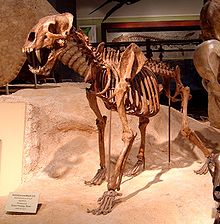| Homotherium Temporal range: Early Pliocene to Late Pleistocene,
| |
|---|---|

| |
| Skeleton of H. serum from Friesenhahn cave, Texas Science & Natural History Museum, University of Texas at Austin, Austin, Texas. | |
| Scientific classification | |
| Domain: | Eukaryota |
| Kingdom: | Animalia |
| Phylum: | Chordata |
| Class: | Mammalia |
| Order: | Carnivora |
| Suborder: | Feliformia |
| Family: | Felidae |
| Subfamily: | †Machairodontinae |
| Tribe: | †Homotherini |
| Genus: | †Homotherium Fabrini, 1890 |
| Type species | |
| Homotherium latidens Owen, 1846
| |
| Other species | |
| |
| Synonyms | |
| |
Homotherium is an extinct genus of scimitar-toothed cat belonging to the extinct subfamily Machairodontinae that inhabited North America, South America, Eurasia, and Africa during the Pliocene and Pleistocene epochs from around 4 million to 12,000 years ago.[1][2] It was one of the last surviving members of the subfamily alongside the more famous sabertooth Smilodon, to which it was distantly related. It was a large cat, comparable in size to a lion. In comparison to Smilodon, the canines of Homotherium were shorter (though still longer than those of living cats), and it was probably adapted to running down rather than ambushing prey, and is suggested to have engaged in cooperative hunting.
- ^ a b Antón, Mauricio. Sabertooth. Indiana University Press, 2013.
- ^ Turner, A. (1997). 'The big cats and their fossil relatives. Columbia University Press. ISBN 0-231-10229-1